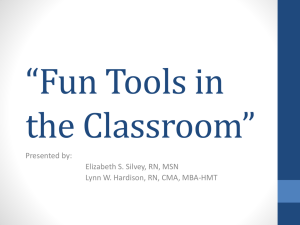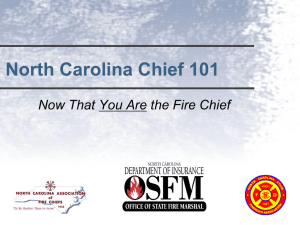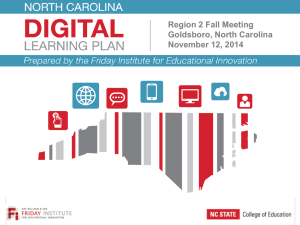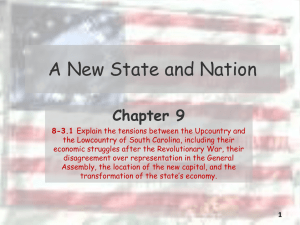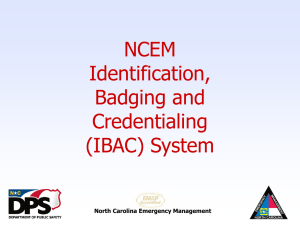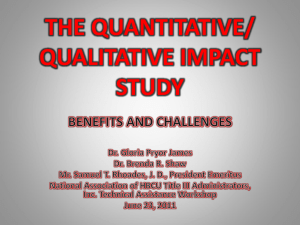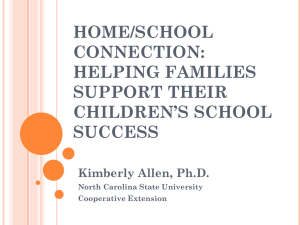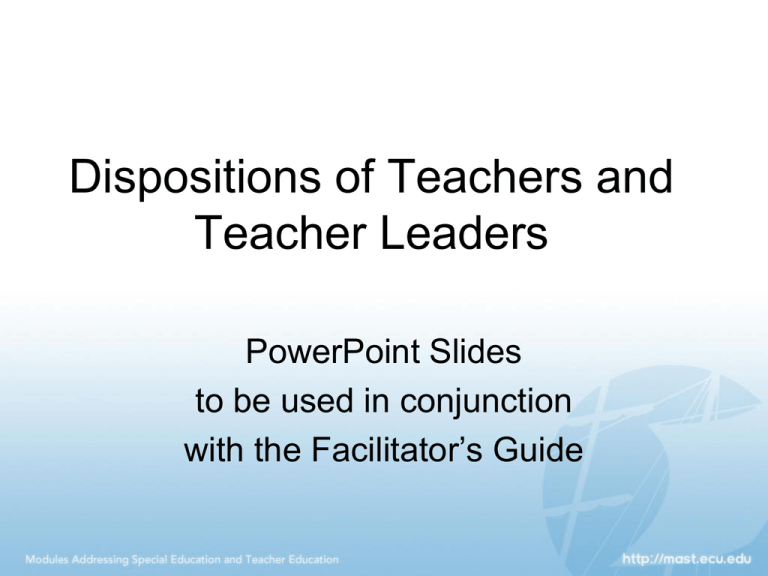
Dispositions of Teachers and
Teacher Leaders
PowerPoint Slides
to be used in conjunction
with the Facilitator’s Guide
Copyright © 2012, East Carolina University.
Recommended citation:
Ward, B., Smith, J., Shelton, D., & Henderson, K. (2012).
Dispositions of teachers and teacher leaders – A
PowerPoint presentation for professional development.
Modules Addressing Special Education and Teacher
Education (MAST). Greenville, NC: East Carolina
University.
This resource includes contributions from the module
developer and MAST Module Project colleagues (in
alphabetical order) Kelly Henderson (Facilitator Guide Editor),
Tanner Jones (Web Designer), Diane Kester (Editor), Sue Byrd
Steinweg (Project Director), Bradley Baggett (Graduate
Assistant), and Sandra Hopfengardner Warren (Principal
Investigator).
Session Agenda
•
•
•
•
•
•
Introduction
Session Goals and Objectives
Set the Course
Demeanor
Interactions
Commitment
Session Agenda, continued
• Leadership
• Summary
• Evaluation
Introduction
• Watch the video of Dr. Vivian
Convington, Director of Teacher
Education, East Carolina University at
http://mast.ecu.edu/modules/dttl/lib/media
/cov_intro.html .
Activity- Introduction
• Read this Associated Press article from November
12, 2008:
CHARLOTTE, N.C. (AP) - Several teachers in the
Charlotte-Mecklenburg school district face discipline
for posting images and material on the socialnetworking site Facebook that school leaders find
objectionable. District spokeswoman Nora Carr told
the Charlotte Observer that officials are
recommending that one teacher be fired for writing
that she teaches "in the most ghetto school in
Charlotte.“ (continues)
Activity- Introduction, continued
Other pages discovered by WCNC-TV of Charlotte
included photos of female teachers in sexually
suggestive poses and a black male teacher who
used a racial slur to describe an activity. A specialeducation teacher wrote, "I hate my students!"
Carr said four teachers face unspecified discipline
that is less than suspension or dismissal.
Activity- Introduction, continued
• Discuss the appropriateness of school
personnel using Facebook, Twitter and
other social media.
– Should seminars covering issues of social
networking and teacher integrity be part of
on-going professional development and
mandatory new teacher orientation?
Session Goal and Objectives
• The goal of this module is to inform and to
guide candidates for all professional
educational roles in developing and
demonstrating ethical behaviors and
attitudes for communicating effectively with
students, communities, and colleagues.
Session Objectives, continued
Objectives: Participants will be able to:
1. Identify examples of professional
demeanor which includes behavior,
conduct, and appearance.
2. Select appropriate professional
interactions including communication,
contributions, and professional growth.
Session Objectives, continued
3. Identify examples of professional
commitment including responsibility,
loyalty, and devotion.
4. Identify examples of professional
leadership including how teachers act as
leaders in the classroom, in the school,
and in the community.
Set the Course
• Watch the slide show at
http://mast.ecu.edu/modules/dttl/lib/media/dt
tl_intro.html .
Demeanor
• Demeanor is defined as the way a
person acts toward other people
including behavior, conduct, and
appearance.
• The three basic tenets of professional
demeanor are:
– Professional Appearance and Attitude,
– Respect for Diversity, and
– Reliability and Ethics
Demeanor, continued
• Watch the slide show at
http://mast.ecu.edu/modules/dttl/lib/media
/slides01/SlideShow.html
• The screens are reproduced on the
following slides.
Professional Demeanor
Art work by Julianne Greer
East Carolina University College of Education Student 2010
Demeanor
The way a person acts toward
other people including behavior,
conduct, and appearance
Professional
Appearance
and Attitude
Three
Basic
Tenets
Reliability
and Ethics
Respect for
Diversity
• One is instantly evaluated based on
appearance, body language, demeanor, and
mannerisms.
•Once this impression is formed, it is nearly
impossible to reverse or undo it.
•Therefore, the first encounter is very
important.
•Your attitude shows in
EVERYTHING you do!
•Put a smile on your face as
often as possible!
•Positive body language is a
sure fire way to project self
assurance, so stand tall,
smile, and make eye contact.
Professional
Appearance
and Attitude
Three
Basic
Tenets
Reliability
and Ethics
Respect for
Diversity
Teachers must understand,
accept, respect, and celebrate
diversity.
Keep in mind issues such as
gender, sex, learning styles,
and special needs of people,
both of students, teachers,
and parents. A teacher must
be accepting and openminded of differences.
The United States of
America is made up of
a vast variety of
cultures, religious
beliefs, races, moral
and ethnic views,
family make-ups and
nationalities.
Professional
Appearance
and Attitude
Three
Basic
Tenets
Reliability
and Ethics
Respect for
Diversity
RELIABILITY
AND ETHICS
R = Resourceful
A professional teacher
must be resourceful with
both materials and ideas.
R
E E= Ethical
The teaching profession
requires the constant
responsibility of being a role
model.
RE
LL= Limits stress and frustration and
responds to these feelings with poise
Regardless of the profession chosen, one
must realize that emotions play a part in
each of our days.
REL
I = Independent Worker
One must be confident in his or her
work in order to work well both in a
group setting and independently.
RELI
A = Accepts responsibility for
A
successes and mistakes.
A successful teacher is one who
celebrates successes and accepts the
challenge of improving in areas that
are of weakness.
RELIA
BB= Believable
Part of being reliable is being
truthful, trustworthy, and loyal to
oneself and others.
RELIAB
II = Initiative is taken on
regular occasions
Taking initiative means knowing when to
stand up and take control of a situation or a
task. One must be confident in his or her
abilities in order to take initiative and
follow through.
RELIABI
LL= Leadership
Leaders should possess all
qualities of professionalism.
RELIABIL
I = Integrity
In order to show true
professionalism, one must
adhere to a strict, moral, and
ethical code.
RELIABILI
TT= Takes responsibility to
complete tasks and duties on
time without prompting
It is the responsibility of the professional to
know what needs to be done and to do so
in a timely manner.
RELIABILIT
Y
Y= Yes, a teacher must
be all of these things
while constantly
adhering to standards!
RELIABILITY
Art work by Julianne Greer
East Carolina University College of Education Student 2010
Interactions
• For our purposes, the word “interactions” is
defined as a mutual or reciprocal action or
exchange. To interact is to act together
towards others or with others. Interactions
are a key component of professionalism.
Educators interact with a variety of people
in many different ways.
• Watch slide show at
http://mast.ecu.edu/modules/dttl/lib/media/s
lides02/SlideShow.html
Professional
Interactions
Interactions
Professional Interactions
The basic tenets of professional interactions include
communication, contribution, and professional growth.
Communication
Basic Tenets of
Professional
Interactions
Professional Growth
Contribution
Communication of Effective Teacher
• Articulates ideas clearly, coherently and comfortably
• Demonstrates conventions of standard spoken and written
English
• Demonstrates awareness of audience during
communication
• Communicates with parents, colleagues and community
• Listens and responds thoughtfully to ideas and
perspectives of others
• Demonstrates awareness of impact of words and actions
• Demonstrates diplomacy, tact and sensitivity toward
feelings and opinions of others
Active Listening
is the skill of listening with purpose with the intent to
understand.
Suggestions for Active Listening
Give the speaker your full attention – show this by using body language
and facial gestures
Acknowledge the speaker’s feelings – check to see if the emotion you
think you see is the correct interpretation
Ask for more information- This enables others to expand on initial
information. It tells the speaker we are interested in his/her
thoughts
Show understanding by paraphrasing- This is saying what you think the
speaker said. It gives the speaker a chance to confirm our
interpretation or clarify what was meant
Using an “I” message is an easy way to defuse interpersonal
conflict while avoiding accusatory language. When using an “I”
statement, you are focusing on your own feelings rather than
starting the discussion with an accusation
•
Using “I” Messages
An I-message is a way to be strong without being mean (that is, assertive) when
you are angry or upset or disappointed with something another person has done.
The formula for an I-message is as follows:
I feel _________________________________ (say your feeling)
when you _____________________________ (describe the action)
because _______________________________ (say why the action connects to
your feeling)
•
*
The "I-message" is different from a "You-message." In a "You-message," you attack
the other person, make judgments about him or her, sometimes even call the
person names.
Activities for practicing “I” messages can be found in Facilitator’s Guide for this module segment
Contributions
Another area of professional interactions is the
contributions that are made to the profession.
• Shares ideas and materials willingly
• Contributes actively to positive group function
• Contributes to the mission, philosophy and goals
of the school
Contributions
• As a student in the area of education, one is exposed to many of the most
recent and updated research findings in terms of technology, brain
information, teaching techniques and strategies. The school systems
depend on the teaching candidates and beginning teachers to share this
information with those who have been in the field longer.
• In addition, teaching candidates and beginning teachers often have a fresh
enthusiasm that comes with being up on the latest information. Such
professionals must be willing to share these current thoughts and ideas
with others while accepting helpful materials and ideas in return.
Contributions
• At the same time, it is important to be able to function in a group setting
where each member contributes actively. Being familiar with the school’s
mission, philosophy and goals will enable you to focus your attention on
the issues that are most important to the students and the school as a
whole.
• Remember that without the Scarecrow’s brain, the Tinman’s heart and the
Lion’s courage, the team probably would not have made it to the Land of
Oz. It is important to keep in mind that each member of a group has
strengths and should contribute accordingly.
Professional Growth
• Participates actively in professional clubs and
organization
• Takes part in staff development activities
• Works toward furthering education
• Accepts constructive criticism
Reflection Cycle
Educational Organizations
•
National Education Association – http://www.nea.org/ A United States labor union committed to
advancing the cause of public education. NEA represents teachers, secretaries and other educational
support personnel.
•
Phi Delta Kappa - http://www.pdkintl.org/ Phi Delta Kappa International is a premier professional
association for educators. For more than 100 years, it has focused its work on the tenets of service,
research, and leadership. PDK is one of the largest education associations and has more than 35,000
members, including teachers, principals, superintendents, and higher education faculty and
administrators. PDK publishes the highly-regarded Phi Delta Kappan, the No. 1 education policy magazine.
•
Future Educators Association - http://www.futureeducators.org/index.htm The Future Educators
Association (FEA), sponsored by PDK International, is an international student organization dedicated to
supporting young people interested in education-related careers. As the co-curricular component of staterecognized Career and Technical Education (CTE) programs of study, FEA helps students develop the skills
and strong leadership traits that are found in high-quality educators.
I have come to the frightening conclusion that I
am the decisive element in the classroom. It is
my daily mood that makes the weather. As a
teacher, I possess a tremendous power to make
a child’s life miserable or joyous. I can be a tool
of torture or an instrument of inspiration. I can
humiliate or humor, hurt or heal. In all
situations, it is my response that decides
whether a crisis will be escalated or de-escalated
and a child humanized or dehumanized.
~Haim Ginnott
Activity- Interactions
• In pairs, interview your partner regarding
a recent professional interaction: a
training, a performance review, a meeting,
email exchange, etc.
• Pay particular attention to the tenets of
professional interactions reviewed in this
section: communication, contributions and
professional growth.
• How did the interaction reflect aspects of
these tenets, if at all?
Commitment
• The noun Commitment means
responsibility; loyalty. The verb Commit
means promise; devotion. Professional
commitment of teachers influences all
aspects of education and schools.
Teaching is complex and demanding work.
• Watch the slide show at
http://mast.ecu.edu/modules/dttl/lib/media/s
lides03/SlideShow.html
Greer, J. (2010). Tin Man Picture.
PROFESSIONAL COMMITMENT
If I only had a heart, thought the Tin Man.
Baum, F. L. (1987). The Wonderful Wizard of Oz.
Chicago: Harper Collins.
Commitment (n) –
responsibility; loyalty
Commit (v) – promise devotion
Suplicki, C. & Molino, G. (ed). (1999). Webster’s Dictionary and
Thesaurus with United States & World Atlas. Nichols
Publishing Group: USA.
Six categories of teacher commitment
1. Teacher commitment as a 'passion’
2. Teacher commitment as an investment of time
3. Teacher commitment as a focus on individual needs of
students
4. Teacher commitment as a responsibility
5. Teacher commitment as maintaining professional
knowledge
6. Teacher commitment as engagement with school
community
Crosswell & Eliott, 2004.
1. Teacher Commitment as a “Passion”
Attitude is everything! A positive
attitude is an essential component of
professionalism. (Hurst & Reding,
2000)
2. Teacher commitment as an
investment of time outside of
contact hours with students.
MicrosoftOffice2008/office/MicrosoftClipGallery.app
3. Teacher commitment as a focus
on the individual needs of the
students.
MicrosoftOffice2008/office/MicrosoftClipGallery.app
4. Teacher commitment as a
responsibility to impart knowledge,
attitudes, values and beliefs.
MicrosoftOffice2008/office/MicrosoftClipGallery.app
5. Teacher commitment as
'maintaining professional
knowledge'.
MicrosoftOffice2008/office/MicrosoftClipGallery.app
6. Teacher commitment as
engagement with the school
community.
MicrosoftOffice2008/office/MicrosoftClipGallery.app
Partnership for 21st Century
Skills
Life and Career Skills
http://www.p21.org
Initiative and Self-Direction
Manage Goals and Time
Work Independently
Be Self-directed Learners
MicrosoftOffice2008/office/MicrosoftClipGallery.app
Manage Goals and Time
•set goals
•balance tactical goals
•utilize time efficiently
MicrosoftOffice2008/office/MicrosoftClipGallery.app
Work Independently
•monitor, define, prioritize and
complete tasks without direct
oversight
MicrosoftOffice2008/office/MicrosoftClipGallery.app
Be Self-Directed Learners
• expand one's own learning
•demonstrate initiative
•Demonstrate lifelong learning
•reflect critically
MicrosoftOffice2008/office/MicrosoftClipGallery.app
“Good teaching cannot be reduced
to technique; good teaching comes
from the identity and integrity of the
teacher.”
Parker Palmer
Palmer, P. J. (2007). The courage to teach: Exploring the inner
landscape of a teacher’s life. San Francisco, CA: Jossey-Bass.
p. 10)
Leadership
• Leadership, as a noun, means the ability
to lead; guidance.
• Lead, as a verb, means to command
others; to be the way somewhere
Leadership, continued
"Teacher leadership is the process by which
teachers, individually or collectively, influence their
colleagues, principals, and other members of the
school communities to improve teaching and
learning practices with the aim of increased
student learning and achievement. Such team
leadership work involves three intentional
development foci: individual development,
collaboration or team development, and
organizational development." (Reading Rockets
http://www.readingrockets.org/article/24932)
Leadership, continued
• Watch the slide show at
http://mast.ecu.edu/modules/dttl/lib/med
ia/slides04/SlideShow.html
PROFESSIONAL LEADERSHIP
Greer, J. (2010). Picture.
There’s no place like home, thought Dorothy .
Baum, F.L. (1987). The Wonderful Wizard of Oz. Chicago: Harper Collins.
Leadership (n) – ability to lead; guidance
Lead (v) – command other; be the way
somewhere
Suplicki, C. & Molino, G. (ed). (1999). Webster’s dictionary and thesaurus with United
States & World Atlas. Reisterstown, MD: Nichols Publishing Group.
What does RESEARCH tell us about
Teacher Leadership?
Reading Rockets. (2008). The Center for
Comprehensive School Reform and
Improvement. Washington, DC: US
Department of Education, Office of
Special Education Programs.
http://www.readingrockets.org/article/24932
Teacher Leadership is a process by
which teachers, individually or
collectively, influence their
colleagues, principals, and other
members of school communities to
improve teaching and learning
practices with the aim of increased
student learning and achievement.
(Center for Comprehensive School Reform, 2008, pp. 287-288)
http://www.readingrockets.org/images/articles
art24932_fig1_leadership.jpg
Teacher
Leaders
• Respected as
leaders
• Learning
Oriented
• Leadership
Capabilities
Leadership
Work
• Valued
• Visible
• Negotiated
• Shared
Leadership
• Supportive
Culture
• Supportive
Principal and
Colleagues
• Time
• Resources
• Development
Opportunities
Means of Leadership Influence
Maintain a
Establish
focus on
trusting and
teaching and constructive
learning
relationships
Interact
through
formal and
informal
points of
influence
Targets of Leadership Influence
I.
•Individuals
II.
•Teams or Groups
III.
•Organizational Capacity
Intermediary
outcome of
leadership
Improvements
in teaching and
learning
practices
STUDENT
LEARNING
North Carolina
Professional Teaching
Standards
Presented by:
The North Carolina Professional
Teaching Standards Commission
North Carolina Professional Teaching Standards Commission. (2007). Text of the NC
professional teaching standards: PowerPoint presentation. Raleigh, NC: Author.
Available from http://www.ncptsc.org/New Standards Presentation -template.ppt,
slide 1.
Standard I: Teachers demonstrate
leadership.
•Teachers lead in their classrooms.
Take responsibility for the progress of all
students
Communicate vision to students
Use data to organize, plan, and set goals
Use a variety of assessment data
throughout the year to evaluate progress
Establish a safe and orderly environment
Empower students
North Carolina Professional Teaching Standards Commission. (2007). Text of the NC
professional teaching standards: PowerPoint presentation. Raleigh, NC: Author.
Available from http://www.ncptsc.org/New Standards Presentation -template.ppt, slide 17.)
Standard I: Teachers demonstrate
leadership.
Teachers demonstrate leadership in the
school.
Work collaboratively with all school
personnel to create a professional
learning community
Analyze data
Develop goals and strategies through the
school improvement plan
Assist in determining school budget and
professional development
Participate in hiring process
Collaborate with colleagues to mentor and
support teachers to improve effectiveness
North Carolina Professional Teaching Standards Commission. (2007). Text of the NC
professional teaching standards: PowerPoint presentation. Raleigh, NC: Author.
Available from http://www.ncptsc.org/New Standards Presentation -template.ppt, slide 18.)
Standard I: Teachers demonstrate
leadership.
•Teachers lead the teaching profession.
Strive to improve the profession
Contribute to the establishment of positive
working conditions
Participate in decision-making structures
Promote professional growth
North Carolina Professional Teaching Standards Commission. (2007). Text of the NC
professional teaching standards: PowerPoint presentation. Raleigh, NC: Author.
Available from http://www.ncptsc.org/New Standards Presentation -template.ppt,
slide 19.)
Standard I: Teachers demonstrate
leadership.
•Teachers advocate for schools and
students.
Advocate for positive change in policies
and practices affecting student learning
Participate in the implementation of
initiatives to improve education
North Carolina Professional Teaching Standards Commission. (2007). Text of the NC
professional teaching standards: PowerPoint presentation. Raleigh, NC: Author.
Available from http://www.ncptsc.org/New Standards Presentation -template.ppt,
slide e 20.)
Standard I: Teachers demonstrate
leadership.
•Teachers demonstrate high ethical
standards.
Demonstrate ethical principles
Uphold the Code of Ethics and Standards
for Professional Conduct
North Carolina Professional Teaching Standards Commission. (2007). Text of the NC
professional teaching standards: PowerPoint presentation. Raleigh, NC: Author. Available from
http://www.ncptsc.org/New Standards Presentation -template.ppt, slide 22.
An attitude of confidence and
initiative are key components of
professional leadership.
(Hurst and Reding, 2000)
“If your actions inspire others
to dream more, learn more, do
more and become more, you
are a leader.”
~ John Quincy Adams
Adams, J. Q. (n.d.). BrainyQuote.com Retrieved December 13, 2010 from
http://www.brainyquote.com/quotes/authors/j/john_quincy_adams.html
Activity- Leadership
• In small groups, review the assigned
sections of Barnett Berry’s Teacher
Leaders Network (TLN) website:
http://www.teacherleaders.org.
• Evaluate the TLN information using the
state Professional Teaching Standards.
• Are the TLN resources consistent with
these standards? Are other aspects of
teacher leadership emphasized in the TLN
resources?
Summary
• Professional dispositions are paramount to
effective teaching and successful student
outcomes.
• Teachers at all stages (preservice, novice,
and experienced) must project ethical
standards and values both professionally
and personally.
• Teachers must present themselves
professionally as they interact with
colleagues, students, and parents.
Summary, continued
• The four components of professional
dispositions described in this module:
professional demeanor, professional
interactions, professional commitment and
professional leadership are overarching
and build upon each other.
• One component is no more important than
the other and all four components exhibit
characteristics of outstanding, master
teacher.
Focus and Reflection Questions
1. If you were talking with a novice teacher, what
stories from your own experiences would you
share concerning communication with peers
and/or parents?
2. What are the biggest challenges to teachers
as leaders?
3. In most states, teachers are required to take
professional develop courses or activities.
What activities have been beneficial to you as
a teacher?
Application and Extension
Activities
1. Listen to the podcast, “What do we
mean by the courage to teach” by
Parker Palmer at
http://www.couragerenewal.org/podcas
t/37-main/59-what-do-we-mean-bycouragetoteach. Write an
autobiographical sketch connecting the
concepts in the podcast and their own
lives.
Application and Extension
Activities, continued
2. Read assigned sections of The Courage
to Teach, or The Courage to Teach:
Exploring the Inner Landscape of a
Teacher’s Life, both by Parker Palmer.
Discuss in groups.
3. Read and discuss the following article:
Mayo, K. E. (2002). Teacher leadership:
the master teacher model. Management in
Education, 16(3), 29-33.
Application and Extension
Activities, continued
4. Interview two teachers and ask the
following questions:
–
–
What are some of the ways teacher leadership is
taking place at your school and in your district?
Identify ways that you think teachers could lead in
their classrooms, in the school, and in the
community.
Report findings, including similarities and
differences between the two teachers.
Application and Extension
Activities, continued
5. Present “Professionalism for Pre-Service
Teachers” a PowerPoint from Montana
State University College of Education
http://www.slideshare.net/Annie05/profe
ssionalism-msu-b-for-student-teacherspresentation.
Self-Assessment
• A self-assessment with response
feedback is available at
http://mast.ecu.edu/modules/dttl/quiz/ .
Participants may take this assessment
online to evaluate their learning about
content presented in this module.
Session Evaluation
• A form for participants to evaluate the
session is available in the Facilitator’s
Guide.

